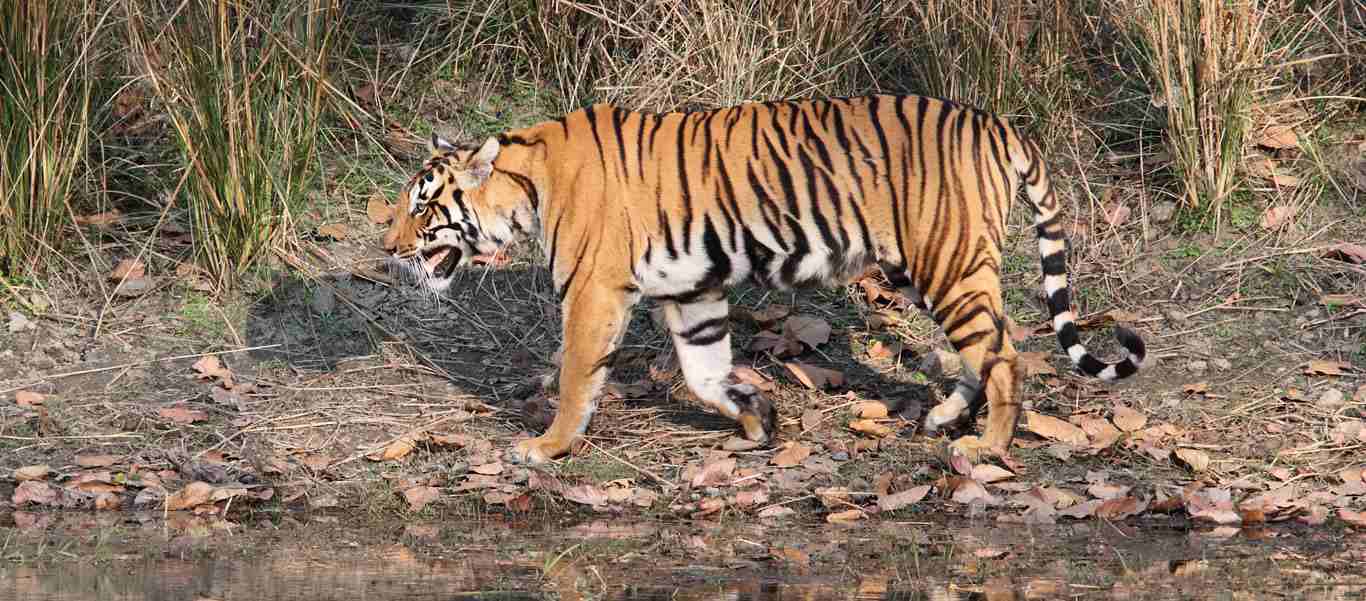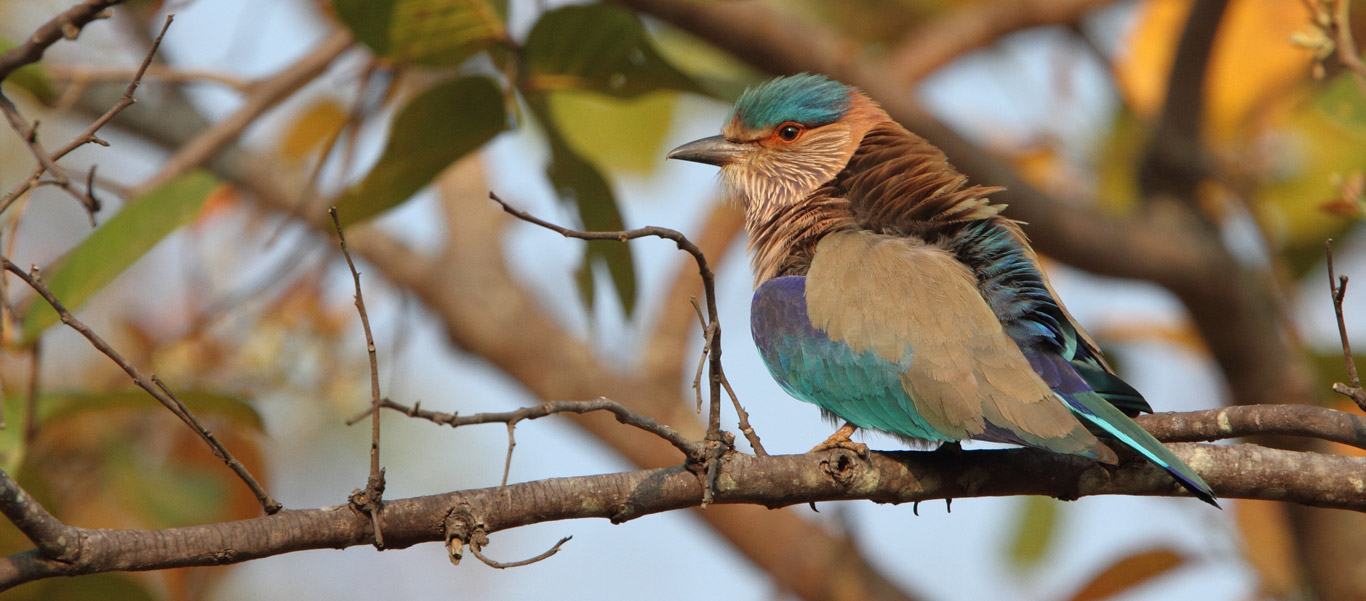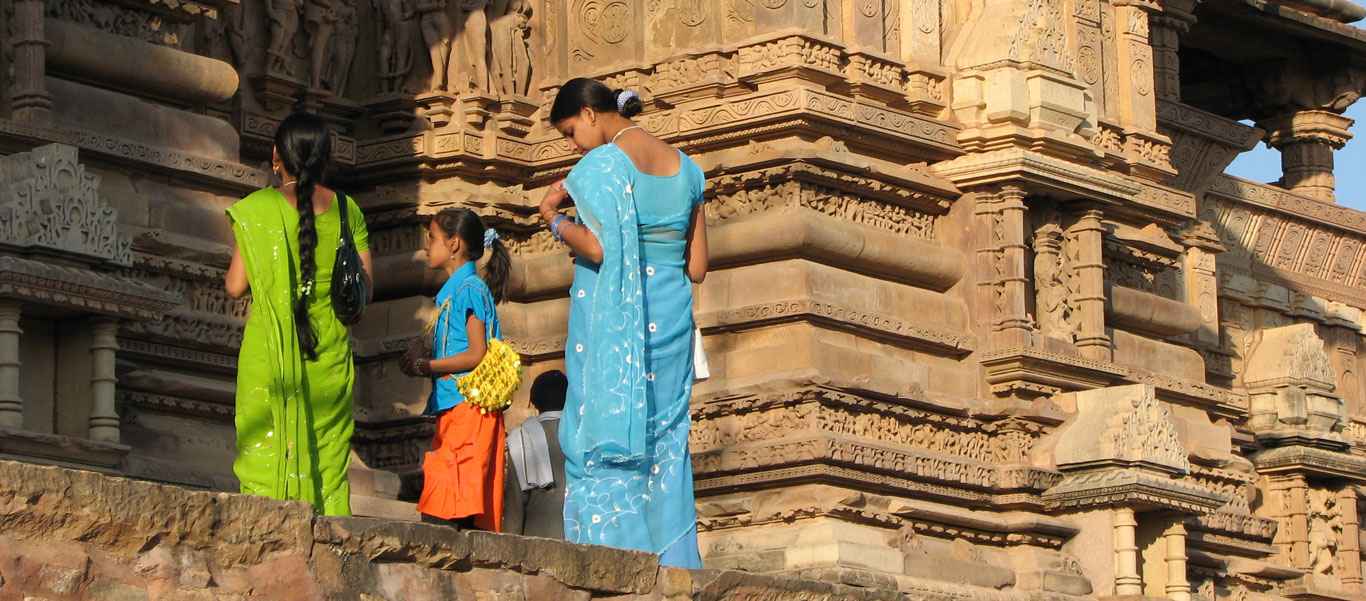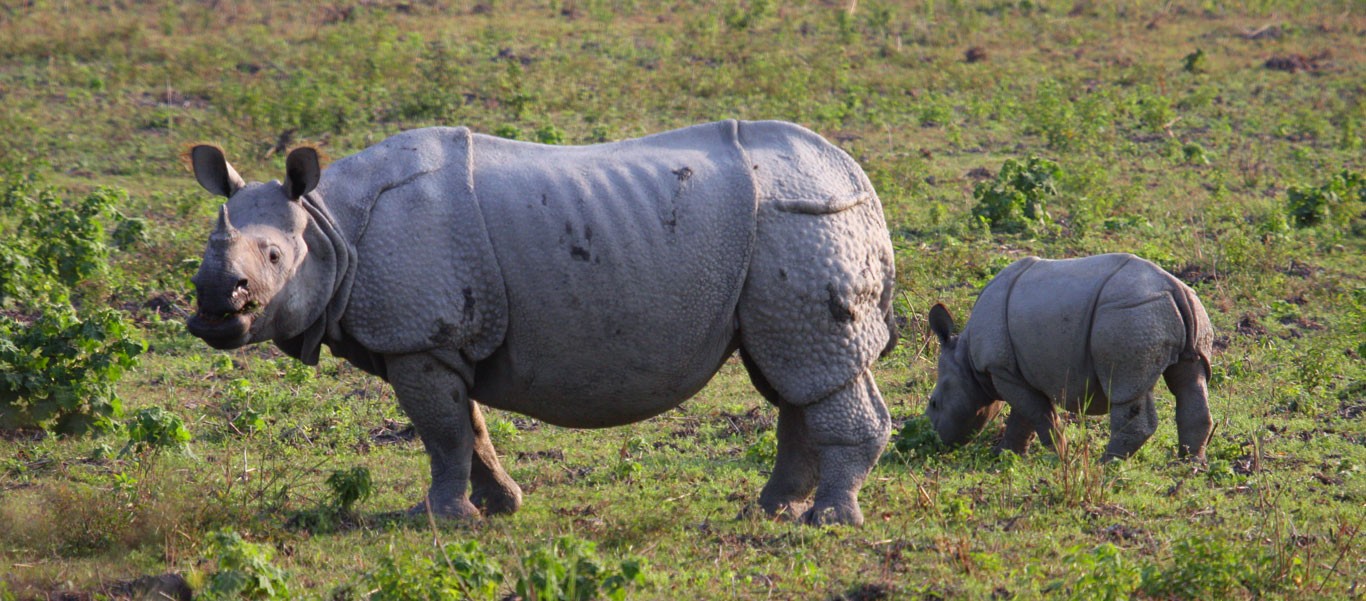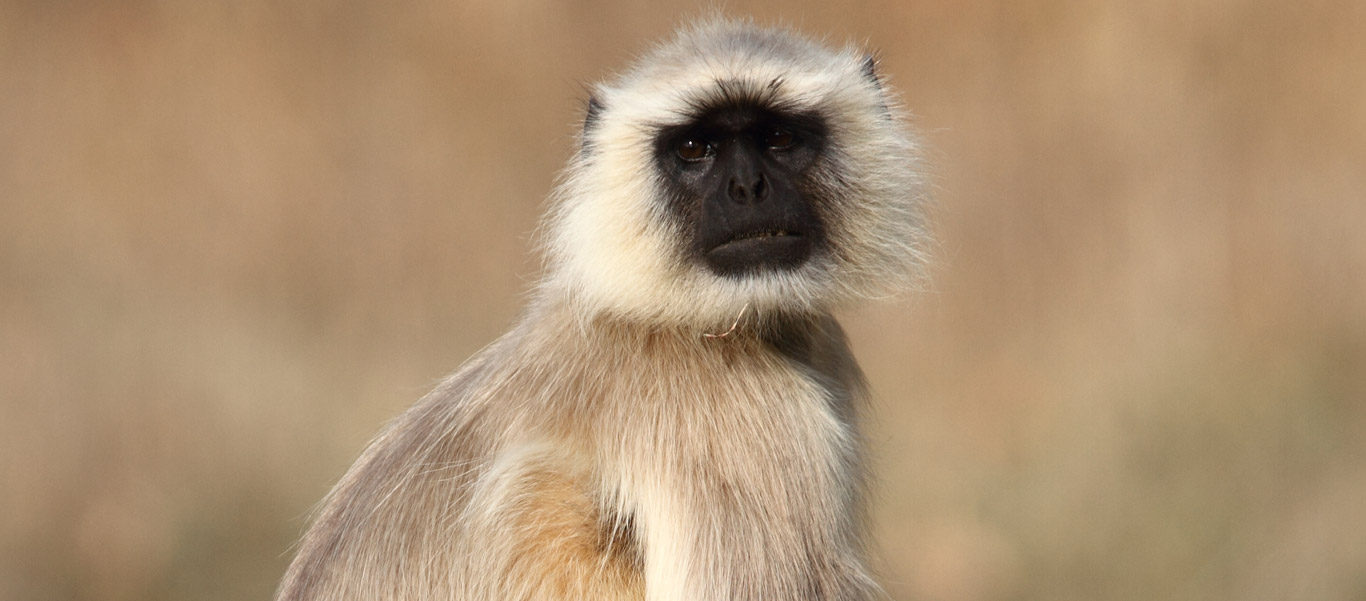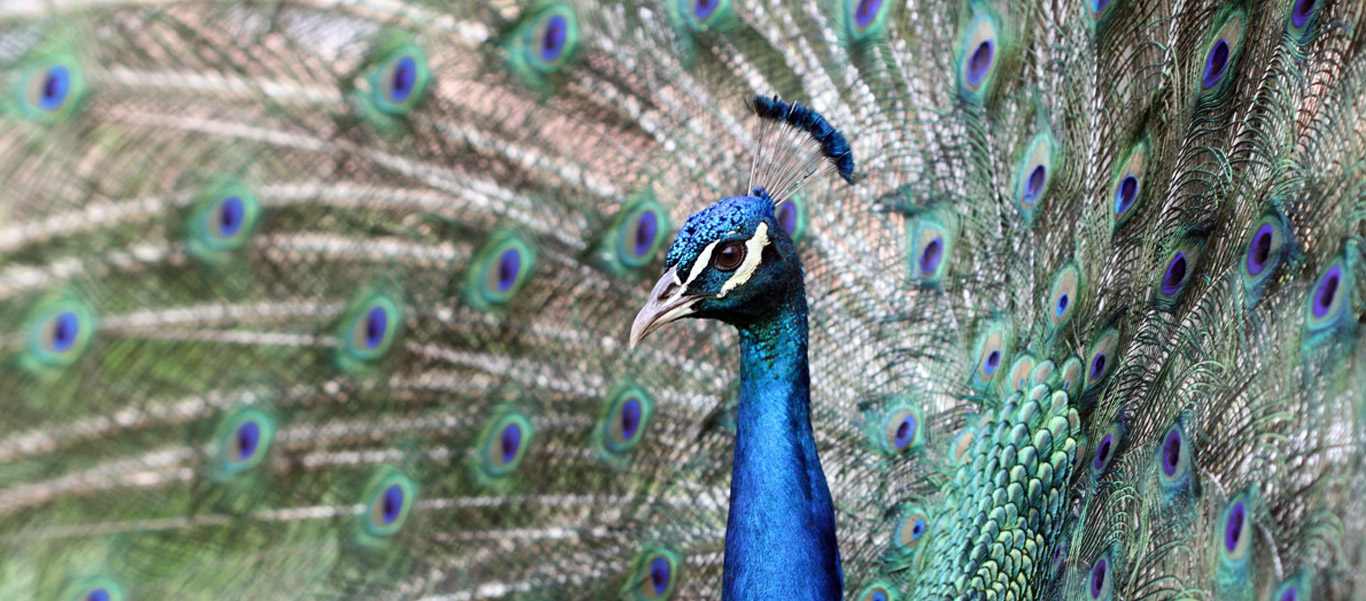India & Nepal
India & Nepal Wildlife Safari
Travelers throughout history have feasted their senses on India’s intoxicating mix of fascinating culture, dramatic landscapes, and abundant wildlife. In this comprehensive 16-day India & Nepal Wildlife Safari Tour, Apex Expeditions takes you from the bustling bazaars of Delhi to the tranquil teak forests of Madhya Pradesh; from tracking tigers in the jungles of the Deccan Plateau to elephant-back safaris in search of Indian Rhinoceros at the foot of the Himalayas; from a dawn cruise on the Ganges at Varanasi, most holy of Hindu cities, to a sunset visit to Boudhnath Stupa, Nepal’s largest Buddhist monument. While our primary focus is the charismatic megafauna of the Indian Subcontinent, our journey exposes us to the incomparable cultural and scenic diversity of this ancient land.

Destinations
- Travel by Air
- Travel by Road
- Travel by Boat
- Travel by Bullet Train
- Travel by Rail
- Travel by Dog Sled
- Day 1
- Day 2
- Day 3
- Day 4
- Days 5 & 6
- Day 7
- Days 8 & 9
- Day 10
- Day 11
- Day 12
- Day 13
- Day 14
- Day 15
- Day 16
-
Thursday, February 12: New Delhi
Arrive in New Delhi and transfer to the Claridges Hotel. Gather this evening for a welcome dinner and briefing. Overnight at the Claridges Hotel.
-
Friday, February 13: New Delhi / Japalpur / Pench
Depart New Delhi on a short flight to Jabalpur, in the central Indian state of Madhya Pradesh. From there, a scenic drive past picture-perfect teak forests and jungle streams will bring you to Pench National Park and Tiger Reserve. Immortalized by Rudyard Kipling in “The Jungle Book,” Pench’s terrain is characterized by both dry, deciduous forest and undulating grasslands, making it choice habitat for a staggering diversity of wildlife, including one of the highest densities of herbivores of any Indian park. In the late afternoon, we venture out on our first open 4×4 safari. Herds of elegant Chital, or Spotted Deer, are a conspicuous feature of the landscape, often accompanied by foraging troops of elegant, long-tailed Hanuman Langurs. We’ll be alert for any sign of the presence of the area’s apex predator, the Bengal Tiger, watching for pugmarks on the sandy tracks or listening for the warning call of deer or Indian Peafowl. Dinner and overnight at Jamtara Wilderness Lodge.
-
Saturday, February 14: Pench National Park
The park gets its name from the Pench River, which winds through it like a python, adding a number of aquatic species to an already long list of wildlife. Renowned as a reliable location for the scarce Sloth Bear, Pench is also home to the elusive Asiatic Leopard and the handsome Dhole, or Asiatic Wild Dog. It’s also a bird-watcher’s dream, with over 250 recorded species, including the impressive Malabar Pied Hornbill, Crested Serpent-Eagle and Madhya Pradesh’s State Bird, the Yellow-footed Green Pigeon. Dinner and overnight at our lodge.
-
Sunday, February 15: Kanha National Park
After breakfast, travel past rich farmland and colorful villages to Kanha National Park. This 366-square-mile preserve was established to save the endangered Barasingha, or Swamp Deer, before being declared part of the Project Tiger network. Take an afternoon safari, before returning for dinner and overnight at Kanha Jungle Lodge, at the edge of the park.
-
Monday & Tuesday, February 16 & 17: Kanha National Park
Kanha’s magnificent Sal forests are home to prolific wildlife, notably India’s largest population of Tigers, and our time in this wildlife Mecca will focus on experiencing, first hand, this most regal of big cats. Beginning every day before dawn, we’ll enter the park with morning mists still hanging over dew-drenched meadows. At sunrise, the forests resound with bird song, from the quiet purring of Jungle Owlets and rich melodies of Orange-headed Thrushes to the raucous crowing of Red Junglefowl. We’ll be especially alert to the warning barks of Sambar, Chital or Barking deer that may lead us to a Tiger padding through the forest. While seeing Tigers will undoubtedly be foremost in our minds, we may also cross paths with Golden Jackal, Ruddy Mongoose, Wild Boar, or even the impressive Gaur, a bison-like animal that is the largest of all the world’s bovids. We’ll ascend the plateau of Bamni Dadar for panoramic views over the park far below. Flamboyant Asian Fairy Bluebirds, Red-whiskered Bulbuls and flocks of Scarlet Minivets enliven the treetops, and in the arid scrub of the plateau we may be lucky enough to glimpse the elusive Chousingha, the world’s only four-horned antelope. This remote part of Madhya Pradesh still preserves its rural tradition, and between our excursions into the park we’ll visit a nearby school for a taste of local village life. The lodge is also renowned for its fine Indian cuisine and you may choose to partake in a cooking demonstration.
-
Wednesday, February 18: Bandhavgarh National Park
After breakfast, drive through extensive teak forests and rolling countryside to the sleepy town of Mandla. See the ruins of the Gond dynasty’s palace and fort, and enjoy a picnic lunch on the Narmada River, second holiest to the Ganges. After lunch, continue to Bandhavgarh National Park. Named for the ancient fortress at the center of the park, Bandhavgarh consists of 168 square miles of Sal and bamboo forests and grassland. Dinner and overnight at Bandhavgarh Jungle Lodge.
-
Thursday & Friday, February 19 & 20: Bandhavgarh National Park
Bandhavgarh Plateau dominates the park’s dramatic landscape, with its sheer cliffs towering 2,000 feet above the surrounding plains. A focal point for countless centuries of human habitation, early ascetics meditated in caves on its flanks and the Rewa dynasty constructed a sacred temple and the Bandhav “Garh”, or Fort, at its summit. The former hunting preserve of the maharajas of Rewa, Bandhavgarh’s rugged wilderness is renowned for supporting over 40 resident Tigers, the highest density on Earth. The reason for this lies in the abundance of prey, particularly Spotted and Sambar deer, Hanuman Langur and Wild Boar, all of which we will commonly encounter in the park’s rich meadows. We enjoy morning and evening game drives to take in all the park has to offer.
-
Saturday, February 21: Khajuraho / Varanasi
After breakfast, drive to the city of Khajuraho, a UNESCO World Heritage site. This once opulent capital of the Chandela dynasty is home to India’s largest concentration of medieval Hindu and Jain temples, famous for their erotic Kama Sutra sculptures. Take an afternoon flight to the chaotic and dauntingly colorful city of Varanasi. Known to the devout as Kashi, or City of Life, Varanasi is the beating heart of the Hindu universe – pilgrims come to the Ghats lining the River Ganges here to wash away their sins in the sacred waters and to cremate their loved ones. This evening, you’ll want to be well situated overlooking the Ganges to witness the glittering Aarti (prayer) ceremony, an experience that won’t soon be forgotten. Overnight at the tranquil Gateway Hotel.
-
Sunday, February 22: Kathmandu
Take an early boat onto the Ganges to see the cremation Ghats, where at sunrise intimate rituals of life and death unfold in plain sight. After breakfast, board your flight to Kathmandu, Nepal, where you visit two of the holiest sites in Nepal, Pashupatinath and Boudhnath. Built in the 4th century, Pashupatinath Temple sits on the River Bagmati, where a continuous cremation takes place. Covered in ash and wearing loincloths, sadhus and sages flock to this two-storied pagoda to honor the god Shiva. Boudhanath is one of the world’s largest Buddhist stupas, or mound-like structures. Boudhanath is unique in that it is built in the octagonal Mandala design and is said to entomb the remains of Kasyap Rishi, a sage respected by both Buddhists and Hindus. Overnight at Dwarikas Hotel.
-
Monday, February 23: Bharatpur / Chitwan National Park
After breakfast, board a flight to Bharatpur on Nepal’s floodplain grasslands, or Terai. From there, it’s a short drive to Chitwan. Meaning “Heart of the Jungle,” Chitwan was Nepal’s first national park. With its rippling terrain, floodplains and tropical and subtropical forests, this World Heritage-listed reserve is one of the premier sanctuaries in Asia for wildlife viewing. It’s especially renowned for its protection of Indian, or Greater One-horned, Rhinoceros, Bengal Tiger and the long-snouted, fish-eating crocodilian, the Gharial. Before sunset, climb atop an elephant for a unique jungle safari, penetrating swamps inaccessible to vehicles, in search of wallowing Indian Rhinoceros. Dinner and overnight at Temple Tiger Resort.
-
Tuesday, February 24: Chitwan National Park
Watch the sun rise over the Terai on a leisurely morning elephant safari through 20-foot-tall elephant grass. In addition to over 500 Indian Rhinoceroses, Chitwan’s rich alluvial grasslands support Hog Deer and healthy populations of both Bengal Tiger and Asiatic Leopard. Its varied habitats and unique location at the foot of the Himalayas has given Chitwan a legendary status amongst bird enthusiasts, with an impressive 550 bird species known from the park. Denizens of the Terai, such as Swamp Francolin, Slender-billed Babbler and the endangered Bengal Florican are, at this season, joined by winter migrants from the Himalayas and beyond, including Greater Spotted Eagle, Yellow-breasted Bunting and the glorious Himalayan Rubythroat. In the afternoon, you have the option of taking a boat ride down the Narayani River in search of Gharial, Mugger Crocodiles, Gangetic Dolphins and Smooth-coated Otters, or going on a naturalist-guided jungle walk to experience the park on foot and learn more about its diverse flora and fauna. If you’re lucky, you’ll spot both Asia’s largest terrestrial mammal – the Asiatic Elephant – and the world’s smallest terrestrial mammal – the pygmy shrew – in one outing.
-
Wednesday, February 25: Kathmandu
It’s farewell to Chitwan this morning, as you make your way back to Kathmandu. A last visit to Boudhanath Stupa at sunset is a must-do, followed by dinner at our hotel’s specialty Krishnarpan restaurant. Overnight at Dwarikas Hotel.
-
Thursday, February 26: New Delhi
Fly to New Delhi early this morning, and take the day to explore this vibrant cultural melting pot. Delhi consists of two starkly different worlds: upscale New Delhi was built as the seat of government for the British Raj; Old Delhi served as the capital of the Mughal Empire. Explore both, taking a rickshaw ride through the dizzying streets of Chandni Chowk, passing the historic Red Fort and winding through medieval bazaars to visit the beautiful Jama Masjid. Then, admire the architectural genius of the Indian Parliament building and presidential palace, followed by a refreshment at one of New Delhi’s swanky cafés. Meet for a festive farewell dinner and overnight at the Radisson Blu Hotel.
-
Friday, February 27: Delhi
Early morning transfer to the airport for your international flight home.

